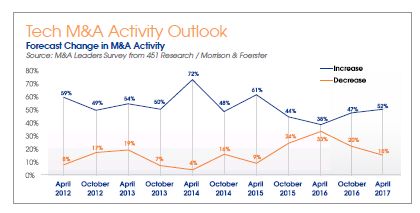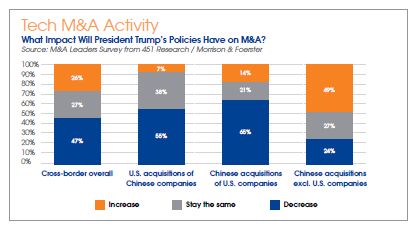Morrison & Foerster,
a leading global law firm, today announced the results of its
semi-annual M&A Leaders Survey, in which the prevailing view is
that technology M&A activity will accelerate over the course of
2017. Slightly more than half of the respondents (52 per cent)
forecast that deal flow will top last year's level; this group
represents more than three times the 15 per cent of respondents who
expect year-over-year activity to decline in 2017. Also, the
majority of respondents (54 per cent) forecast an increase in
private equity activity as compared with 2016.

The survey follows a relative slowdown in the number of deals
during the first quarter of the year, though there was an increase
in aggregate value. According to 451 Research's M&A
KnowledgeBase, there were 912 deals with an aggregate value of USD
77 billion in Q1 2017, compared to 1,065 deals with an aggregate
value of $74 billion in Q1 2016. However, 2017 comes after two
years of the highest tech M&A spending since the Internet
bubble burst. Collectively, acquirers in 2015 and 2016 announced
deals valued at more than USD 1 trillion, according to the M&A
KnowledgeBase.
"The survey forecast represents the most bullish outlook in
two years," said Robert Townsend, co-chair of Morrison &
Foerster's Global M&A Practice Group. "The slight
slowdown in Q1 activity is almost entirely attributable to less
shopping by corporate acquirers. Still, we are encouraged by the
optimism around tech M&A in the U.S. for the rest of the
year."
Other key findings, takeaways, and analysis from the M&A
Leaders' Survey include the following:
Financial Acquirers Key to Overall Market Activity
Survey respondents expect that financial buyers – the
rivals to tech vendors for many targets – will play a major
role in overall market activity. That was true for this year (with
54 per cent forecasting an increase in private equity activity
compared with 2016) and even more so when the timeline was extended
out to 2020 (with 59 per cent anticipating an increase in PE
activity compared with 2016).
PE firms are expected to focus on a mix of old and new M&A
strategies, according to the survey. Respondents predicted that
"bolt-on acquisitions" would see the largest increase in
activity from buyout shops through 2020, which is unsurprising
given that buyout shops typically acquire two or three times as
many bolt-ons as platforms in any given year, and they usually
involve smaller, less-risky transactions. However, the survey
respondents' second-ranked strategy of recapitalising venture
capital-backed startups comes as a relatively novel driver of PE
activity. Up until now, there have not been many of those types of
transactions, but as companies inside venture portfolios continue
to age beyond the 8- to 10-year holding period for most VC firms,
the startups may seek new backers. The demographics of the startup
ecosystem appear to support this trend.
Cross-Border M&A to See Change
Part of what will help M&A accelerate this year, at least in
the view of a plurality of survey respondents, is the new
administration in the United States. Four out of ten (41 per cent)
forecast that President Trump's future economic policies will
stimulate dealmaking, almost twice the 22 per cent who said his
policies will slow M&A.

Conversely, M&A between the two largest economies in the
world, the United States and China, is expected to be particularly
difficult in the coming years.
Two-thirds of survey respondents (65 per cent) predicted that
Chinese acquirers will slow their purchases of U.S. tech companies,
more than four times the 14 per cent that said the opposite.
Similarly, more than half (55 per cent) of the survey respondents
said U.S. companies will do fewer tech deals in China. That
sentiment is already coming through in the actual deal flow, where
Chinese acquirers of Chinese tech assets have outnumbered U.S.
buyers of Chinese tech assets three to one, according to 451
Research's M&A KnowledgeBase. Still, 49 per cent of survey
respondents expect an increase in acquisitions by Chinese companies
in countries other than the United States.
Find out more about the survey results
here.
About the M&A Leaders Survey
The survey – a partnership project between Morrison &
Foerster and tech market intelligence firm 451 Research now in its
11th edition – examines significant developments in deal
terms, as well as sentiments and trends in key technology markets
across the United States and the most active countries and regions
internationally. This survey was conducted in April 2017 and had
over 150 participants, primarily corporate or M&A executives
(44 per cent of respondents) and investment bankers (42 per cent of
respondents), with the remaining responses coming from lawyers,
VCs, PE professionals, and others in the M&A community. Roughly
9 out of 10 responses came from dealmakers and advisers based in
the United States; Silicon Valley represented the largest single
location, accounting for some 40 per cent of the total.
NOTEWORTHY DEALS
Below we highlight for you some of the noteworthy transactions
involving Europe that may provide you with valuable insights into
recent trends or developments.
HNA to assume control of storage business of Glencore UK
Chinese conglomerate HNA Group Co. Ltd. reached an agreement
with Glencore plc, a listed company on the London Stock Exchange,
to acquire 51 per cent of its petroleum products, as well as the
storage and logistics business of Glencore. With said acquisition,
HNA will assume control. The transaction, valued at USD 775
million, provides for the formation of a new company, HG Storage
International, in which the operation of oil storage assets in
Europe, Africa and the Americas will be combined. The deal is
expected to close in the second half of 2017.
Georgsmarienhütte Holding to separate from railway
business
Georgsmarienhütte Holding GmbH, a German-based group,
agreed to sell its railway system business, including the
subsidiaries in Bochum, Ilsenburg, and Brand-Erbisdorf, Germany, as
well as one subsidiary in Brazil, to a Chinese investor consortium
led by Full Hill Enterprises Ltd. The parties agreed not to
disclose any details of the transaction, which was closed in March
2017.
A cross-office team of MoFo acted as lead counsel to the
purchaser, including attorneys from the Hong Kong and Berlin
offices.
Clariant to merge with U.S. competitor Huntsman
Clariant, a Swiss-based chemical company listed on the Swiss
Stock Exchange, reached an agreement with its U.S. competitor
Huntsman, a Texas-based NYSE-listed company, for a merger of
equals, creating a leading global specialty chemical company. The
merged company, with the new name "HuntsmanClariant", is
considered to have sales of approximately USD 13.2 billion and an
EBITDA of approximately USD 2.3 billion. The merged company will
have its legal seat in Switzerland but will be managed from The
Woodlands, Texas. The transaction provides for a 52 per cent stake
of the Clariant shareholders and a 48 per cent stake of the
Huntsman shareholders.
Merger of Deutsche Börse and London Stock Exchange blocked
by EU competition authority
Merger plans by Deutsche Börse AG and the London Stock
Exchange to create a unified major stock exchange operator in
Europe were finally blocked by the EU competition authority, the
Competition Directorate General of the European Commission. During
regulatory scrutiny, the authority required the LSE to divest its
holdings in MTS, an Italy-based electronic trading platform for
government bonds, making such divestment a condition for approval.
Due to the LSE's declaration of intent not to comply with such
requirement, the EU competition authority had to block the
transaction one day after Britain formally triggered Article 50
proceedings. The transaction attracted much attention, since both
parties had pledged to continue and had given assurance that they
would close the transaction despite the Brexit vote. The blocked
merger deal is the third failed attempt at a merger between the two
companies.
GE to invest in 3D printing company
NYSE-listed company General Electric acquired Concept Laser, a
leading provider of machine and plant technology for 3D printing of
metal components based in Lichtenfels, Germany. With the
acquisition of Swedish Arcam, GE becomes the world's market
leader in industrial 3D metal printing. GE plans to invest
approximately EUR 100 million in the site in Lichtenfels, and there
are also rumors that GE might locate the worldwide seat of its
newly formed division GE Additive in Lichtenfels. Sales of Concept
Laser most recently amounted to up to 400 units with a return of
approximately EUR 91 million.
Japanese Nidec acquires manufacturer of special compressor for
refrigerating and freezing appliances
Nidec Corporation, a Kyoto-based corporation listed on the
Nikkei, reached an agreement with Aurelius Equity Opportunities, a
capital investment company based in Germany, for the sale of the
SECOP Group, a leading manufacturer of compressors in refrigerating
and freezing appliances. The deal has a volume of EUR 185 million,
making it the largest company sale in the seller's history,
earning approximately 11 times its invested capital after seven
years. The sale will have a positive effect on Aurelius' group
profit of approximately EUR 100 million, according to a company
press release. The transaction is pending regulatory approval and
closing is expected in the coming months.
Chinese investment group to invest in German biotech
company
Chinese investment group Creat reached an agreement for the
takeover of Biotest, a Frankfurt Stock Exchange-listed biotech
company operating in the field of plasma protein products. The
major shareholder of Biotest, the founding family of Schleussner,
agreed to sell its 51 per cent stake in Biotest. Including debts,
accruals, and cash balance, Creat agreed to pay approximately EUR
1.3 billion. The deal provides for a payment of EUR 28.50 per
ordinary share and EUR 19 per preferred share. The takeover of
Biotest follows the purchase of UK-based Bio Products last year
with a volume of GBP 820 million.
Bosch to sell its starter motor business to Chinese investor
consortium
German automotive supplier Bosch entered into an agreement for
the sale of its starter motor division that includes 16 sites in 14
countries. The purchaser is Zhengzhou Coal Mining Machinery Group,
a manufacturer of machines used in coal mining and of automotive
parts, and China Renaissance Capital investment, a Hong Kong-based
private equity company managing a fund worth up to USD 2 billion.
All parties agreed to non-disclosure of any details of the
transaction, but the deal is considered to involve a cash payment
of EUR 545 million. The transaction is still pending regulatory
approval.
Cathay Fortune to acquire medical engineering specialist
Epigenomics
Hong Kong-based investment company Cathay Fortune offered
shareholders of Epigenomics, a medical engineering specialist
company based in Frankfurt, EUR 7.52 per share in cash, totaling
EUR 171 million.
The offer price exceeds by almost 50 per cent the average share
price of the last three months. Founded in 1998 and listed in the
Prime Standard of the Frankfurt Stock Exchange, Epigenomics
specialises in molecular diagnostics and develops blood tests for
colorectal cancer pre-diagnostics. Cathay Fortune uses an
acquisition vehicle with the name Summit Hero in which the major
shareholder of Epigenomics, the Chinese diagnostics company
Biochain, also holds a stake via an exchange of its stakes in
Epigenomics. The takeover offer is currently under scrutiny by the
German securities exchange authority, BaFin.
Chinese automotive supplier to acquire a stake in Grammer
Chinese automotive supplier Ningbo Jifeng acquired convertible
bonds in Grammer, a manufacturer of headrests, armrests, and car
seats based in Amberg, Germany, worth up to EUR 60 million,
pursuant to which Jifeng is entitled to approximately 9.2 per cent
of the shares in Grammer. With said stakeholding, Jifeng seeks
strategic alliances with Grammer. The acquisition is an important
step in fending off a feared cold takeover: Grammer faces pressure
from Prevent Group, owned by the Bosnian investor family Hastor,
who seeks to replace the management of Grammer with managers of the
group, alleging misconduct and statutory violations by the current
management.
Prevent Group attracted attention last year after a dispute with
Volkswagen, which led to a temporary breakdown of production in
Wolfsburg.



